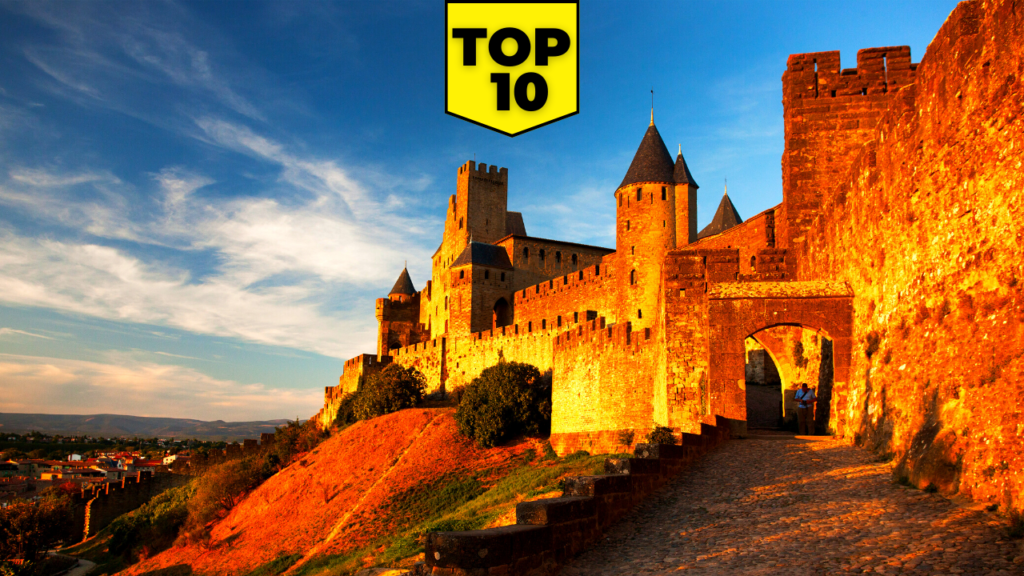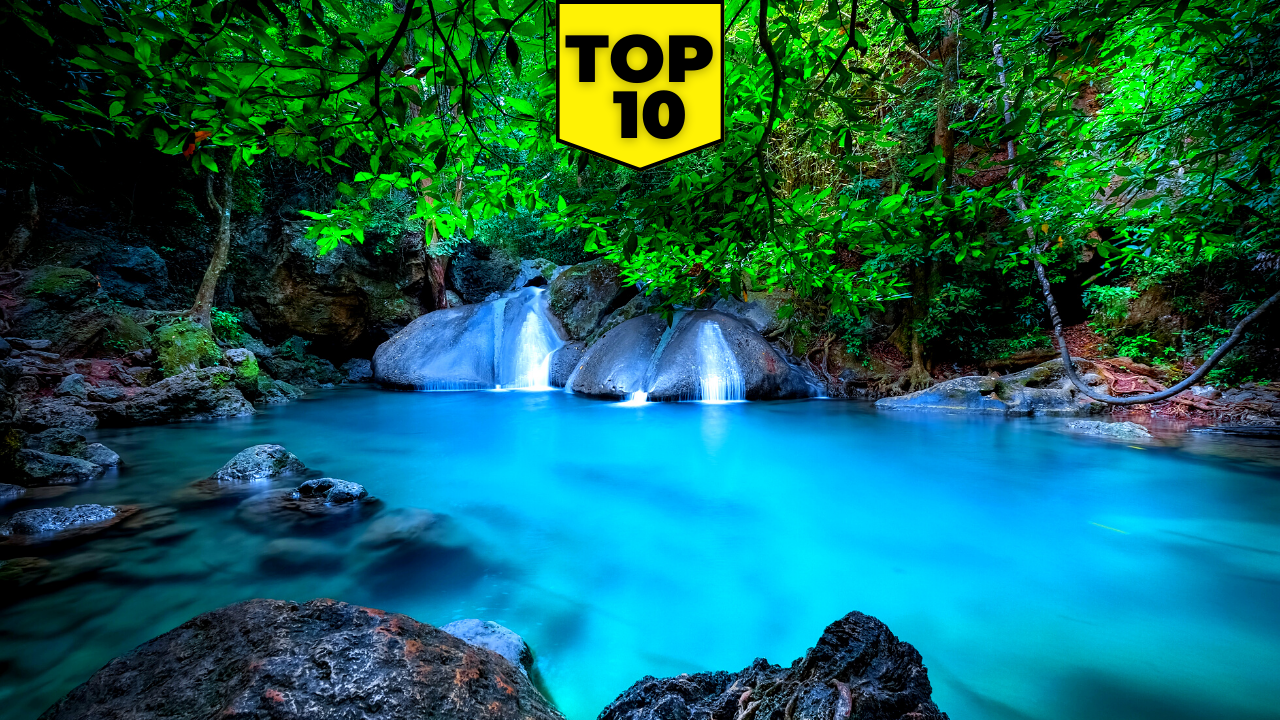
Carcassonne, a UNESCO-designated World Heritage Site, is perched in the Languedoc region of southern France. Despite not being the largest city, it is one of the main tourist destinations in the south of France with four million visitors per year.
Some of the top things to do in Carcassonne include vineyards tours, wine caves, abandoned castles, and the tranquil green banks of the Canal du Midi.
Delightful discoveries await. Without any further ado, here are the top 10 things to Carcassonne France
Table of contents
1.0 Lac De La Cavayere
This is an artificial lake in the Occitanie region of France, close to the medieval town of Carcassonne. Only twenty minutes by car or bus from the city. The lake is formed by a dam that was built in 1988.
There are 40 hectares of water and pine forests, three tiny beaches, a grassy area, and a ton of summertime activities for kids to enjoy. You can rent pedalos, play mini-golf, or climb over an inflatable playground on the lake.
On a 5 km loop that circles the lake, walkers and athletes will encounter a mountainous setting with beautiful views. It doesn’t end there.
You can also find beach volleyball courts, a beach bar, board sports with a waterski ropeway, and a sun-kissed ambiance. With the breathtaking pine forest treetop walk and the exhilarating zip-wires across the lake, adventure is never far away.
The stunning water jump, two 21-meter slides, and 8-meter high jumps are among the several inflatables in the Aquaviva park, which is annually welcomed by the lake.
9. Carnot Square
Carnot is the Bastide’s main square and its beating heart. There are lovely bourgeois buildings, plane trees, cafes, terraces, and restaurants lining the charming pedestrian area. If you go to Carcassonne, you must go see it.
The enormous fountain with pink marble basins, created in 1770 by the Italian sculptor Barata and dedicated to Neptune, the ruler of the waters, lies in the middle of the square. It is the Bastide’s busiest square and a genuine gathering place.
Tuesday, Thursday, and Saturday mornings, the market which sells fruits, vegetables, cheeses, and wines, can also be held here. The square is transformed into a sizable ice rink and chalets during the holiday season.
There are also some magnificent bourgeois hotels from the 17th and 18th centuries located close to the market halls. These artifacts from Carcassonne’s famous fabric age attest to its prosperous commerce past.
The Senechal House, built in the fourteenth century and now home to the current Chamber of Agriculture, and the Rolland Hotel, built in the middle of the eighteenth century and now serving as the city hall, are two of the most notable examples. Both have lavish staircases and intricate carvings on their front doors.
8. Canal Du Midi
The Deux-Mers Canal project, which planned to connect various waterway segments to link the Mediterranean and the Atlantic, began with the Canal du Midi.
It is a tangible example of the skill and ingenuity of Louis XIV’s engineers, who overcame challenging hydrographic and geographical constraints to accomplish the legendary ideal of the “junction of the seas.”
Initiating and influencing the contemporary age of building navigable networks across the industrialized nations of Europe and North America was its extensive technological and cultural impact.
The Canal du Midi, which was created in the 17th century and is credited to Pierre-Paul Riquet, helped link the Atlantic and Mediterranean coasts.
7. Languedoc Vineyard
One of France’s oldest and biggest vineyards is in the Languedoc region. In the fifth century BC, the Greeks planted the first vineyards there. Vine cultivation is best in Languedoc’s Mediterranean environment.
Along with the climate, the richness of the terroirs and the variety of the soils enable the production of a wide range of red, white, and rosé wines. You can explore the wineries’ grounds, cellars, and wines at the ones we’ve chosen close to Carcassonne.
You can visit the Château of Pennautier, which is 5 kilometers from the gates of Carcassonne, to start your exploration of the Languedoc vineyards. This castle is a piece of the Lorgeril complex, a building owned by a prominent Languedoc wine-growing family since the 17th century.
With six vineyards in the South of France, including the Château of Pennautier, this family has a long and illustrious history. The winery is a stunning old building with an on-site restaurant that serves delicious wine and food pairings. White, red, and rosé wines are all available, most of which are from the Cabardès region.
There’s also Château La Villatade, a very old 130-hectare winery composed of vineyards, olive groves, forests, and scrubland. The winemakers will be delighted to introduce you to their work, their passion, and their wines, regularly rewarded in a specialized guide.
6. Bastide Saint-Loius
St. Louis built the “new city” on the left side of the Aude River. He gave the order to build the Lower Town in 1257 with the intention of housing the populace and keeping them away from the Trencavel.
The city first grows economically through the manufacture and export of woolen sheets, eventually displacing the City. Carcassonne’s city of commerce and residence is now known as Bastide Saint-Louis.
This walled medieval town is laid out in a checkerboard pattern, with short streets intersecting at right angles and congregating in Carnot square. You may walk to the Bastide about 25 minutes from the old city.
At the Bastide’s southeast entrance, you will pass by the Old Bridge. It is presently only accessible by foot and makes for a great tourist location because on a clear day, you can see both the city and the Pyrenees.
Additionally, the bridge is considerably more attractive at night thanks to the lovely lighting.
5. Cathar Castles
Carcassonne has also a popular destination when it comes to Cathar Castles which are known as the “The Five Sons of Carcassonne” which are full of history and can be explored as well. They are Aguilar, Peyrepertuse, Puilaurens, Queribus and Termes.
Whenever siege warfare raged, the five Cathar castles were the first line of defense when it comes to defending Carcassonne. This solid front line was sufficient to quell the Kingdom of Aragon’s ambitions.
However, The Treaty of the Pyrenees, which was signed in 1659 by Louis XIV and Philip IV of Spain, legalized Infanta Marie Therese’s union with the French King.
The treaty changed the borders, transferring Roussillon to France as part of the dowry, and relocating the international border to the crest of the Pyrenees, which is now the border between France and Spain.
4. Eglise Saint Gimer
At the base of the city, in the Barbican neighborhood, is the Saint-Gimer church. Built by Viollet-Le-Duc in the 19th century, between 1854 and 1859, in the heart of the old Aude Barbican, now completely destroyed, it guarded the entrance to the Aude river.
Before the church was built, there was the Saint-Gimer chapel in the area. On the spot where Saint Gimer, the first bishop of Carcassonne, was born at the start of the 10th century, a building was constructed in the 17th century.
It is one of the three churches Viollet-le-Duc designed and was intended to be an addition to the previous Saint Gimer church. The church owes its name to Saint Gimer, bishop of Carcassonne from 902 to 931. He is known for his charity toward the poor. His childhood was illustrated by the miracle of bread.
3. Chateau Comtal
NUMBER THREE, CHATEAU COMTAL. The Trencavel, the city’s viscounts, built this enormous fortress in the middle of the city in the 12th century. Under their wealthy dynasty in the 12th century, the castle’s courtyard frequently hosted troubadours, poets, and academics from all over the Mediterranean.
In 1226, it was transformed into a citadel. It is affixed to the Gallo-Roman wall and is situated at the summit of a hill overlooking the Lower Town. This enormous structure, which measures 80 meters in length and 40 meters in width, is a true “fortress inside a castle” and a stunning example of medieval military design.
A self-guided tour is available for the castle’s lapidary museum. Through a rich collection of artifacts from the area from antiquity to the 17th century, it depicts the various periods of the history and restoration of the castle.
Additionally, a city model created and categorized by Louis Lacombe is on display, and the castle frequently holds temporary exhibitions of modern art.
Finally, you will have the chance to combine a conference tour with an engaging historical presentation that will take you to the castle’s most secluded locations, including the inquisition tower and its former torture chamber.
2. Basilica of Saints Nazarius and Celsus
In the French castle of Carcassonne, there is a tiny Roman Catholic basilica called the Basilica of Saints Nazarius and Celsus. It relates to the Gothic-Romanesque architectural style and is a national monument.
Pope Urban II visited the community on June 12th, 1096, and blessed the building supplies for the cathedral. The building was finished in the first decade of the twelfth century. It was erected over the remains of a Carolingian cathedral, which were completely destroyed.
Despite appearing ancient, the crypt was also part of the new building. The cathedral was rebuilt in the Gothic style in the latter half of the 13th century, under the rule of kings Philip III and Philip IV as well as the episcopates of Pierre de Rochefort and Pierre Rodier.
Up until 1803, when the current Carcassonne Cathedral took its place as the city’s cathedral, it retained that designation. In 1840, the Church of Saints Nazarius and Celsus was given historical monument status.
The church and the remainder of the citadel were restored during this period by architect Eugène Viollet-le-Duc. The church was raised to a minor basilica in 1898.
1. The Historic Fortified City of Carcassonne
Carcassonne’s rampart-encircled fortification was constructed on a steep rock outcrop more than two thousand years ago. The 52 stone towers and two sets of battlements that surround the walled town are topped with characteristic “witch’s hat” roofs added by architect Viollet-le-Duc during 19th-century restorations.
Keep in mind that you must pay to visit Château et Remparts in order to go on the ramparts. Over the years, many different peoples have defended the hill where the Cité Mediévale is located, including Gauls, Romans, Visigoths, Moors, Franks, and Cathars.
The castle’s utility as a fortification on the frontier decreased once Roussillon was annexed by France in 1659, and it gradually fell into disrepair. Viollet-le-Duc, who put his stamp on many of France’s medieval landmarks, including Notre Dame in Paris and Vézelay in Burgundy, saved it from being destroyed. The double wall and defensive towers of the castle are arranged in a circular fashion to fend off attacks from siege engines.
The Porte Narbonnaise’s main entrance, which leads into the citadel’s interior, a labyrinth of cobblestoned roads and courtyards that are today primarily surrounded by shops and restaurants, still has a drawbridge.
Porte d’Aude, the second gate of the castle, lost its drawbridge after being partially demolished in 1816. A room known as Les Lices extends around the castle for just over a kilometer inside the walls.



